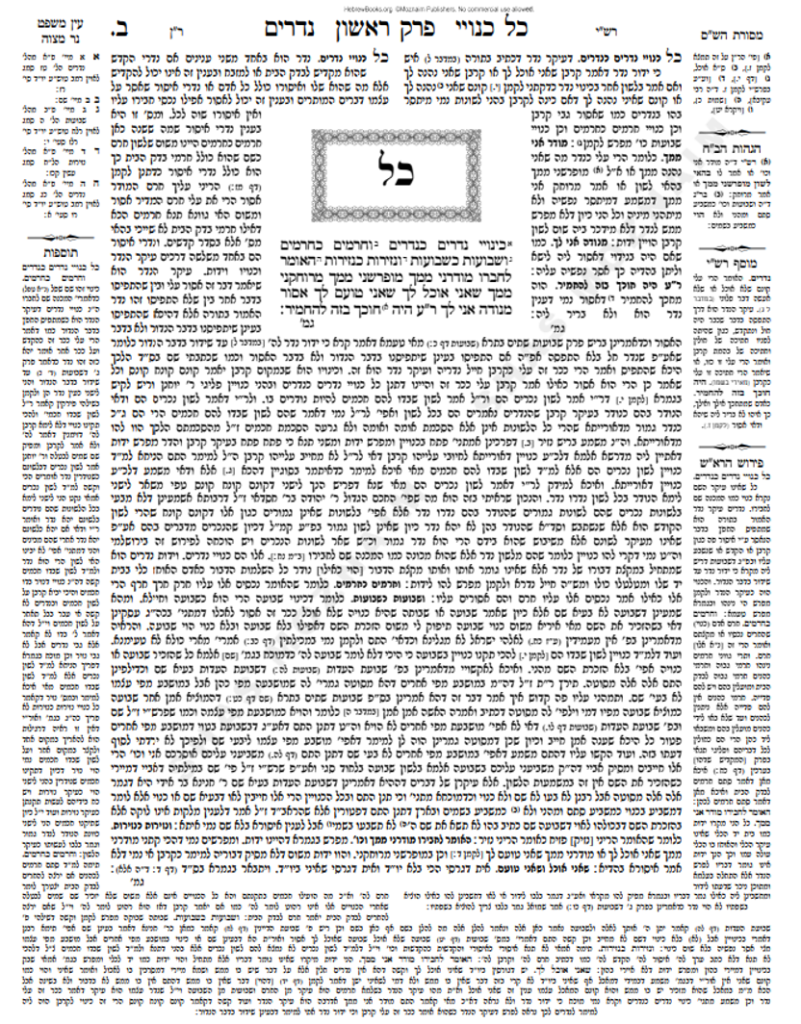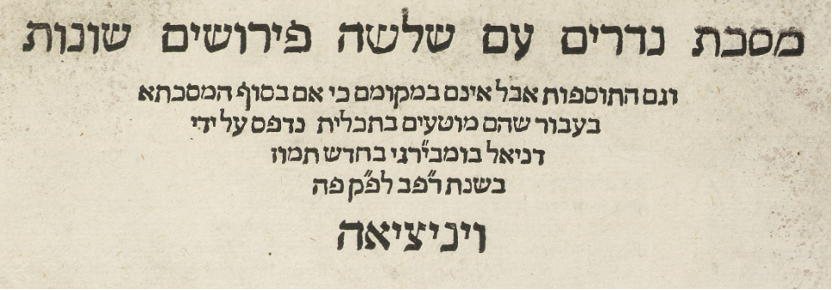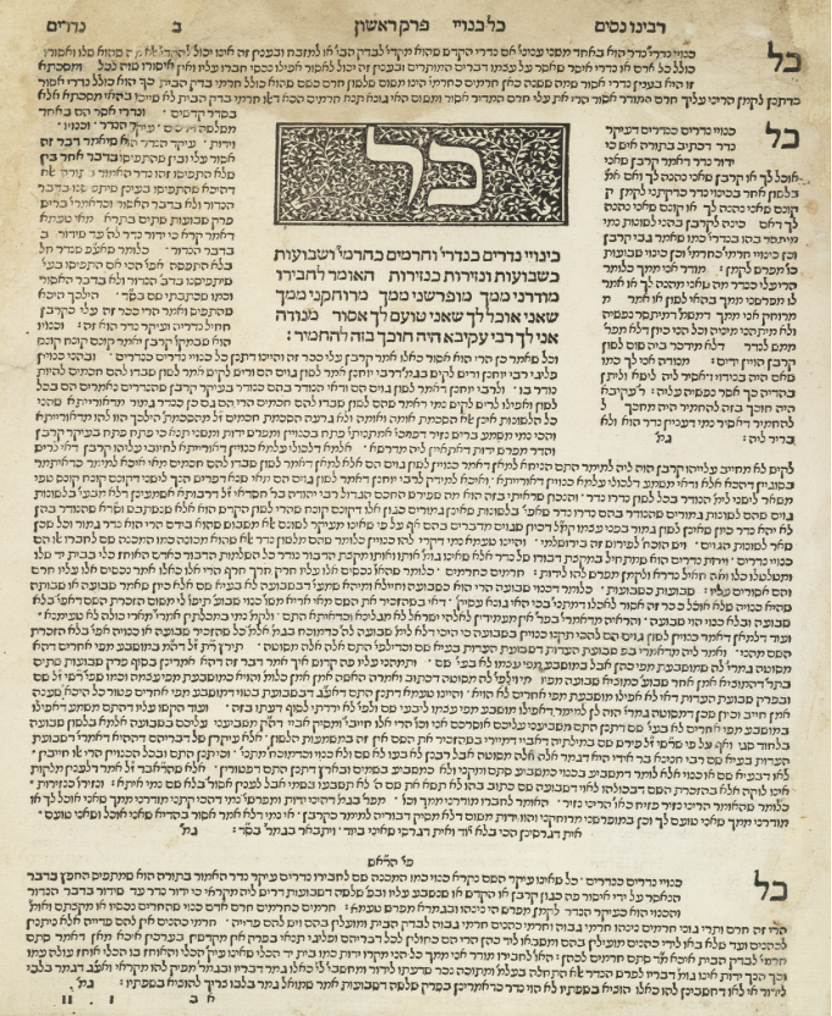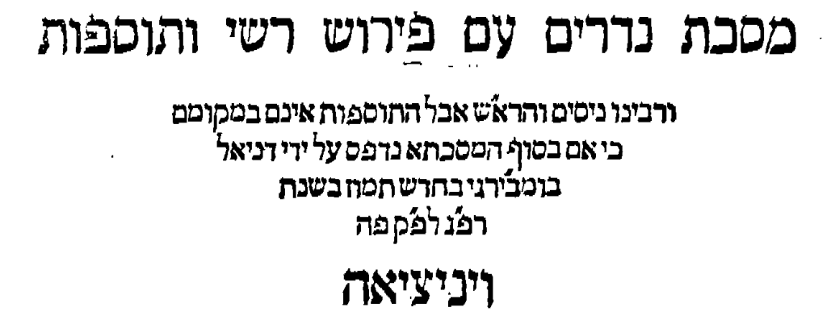Written by Nathan Hirsch
In honor of the start of Mesechet Nedarim in the Daf Yomi cycle, I’d like to present a short history of the printing of the Rishonim on the Daf, and explore why Nedarim is different from other Mesechtot, and how that came to be.

For those familiar with the traditional layout of the Talmud, questions arise upon first glance at Mesechet Nedarim:
- On the outer portion of the page, where the Tosafot are normally printed, we find the commentary of the Ran.
- The Tosafot themselves have been pushed to the margins of the page.
- Additionally, the Rosh’s commentary can also be found on the margins.
To these observations I would like to add another anomaly which is not as clearly visible, and that is that Rashi’s commentary on the tractate is falsely attributed to him.
If so, a simple examination of the Rishonim printed on the Daf presents us with four oddities.
Before we examine them separately, I’d like to take a look at the origin of this peculiar layout – the first printing of the Masechet.
Masechet Nedarim was first printed by Daniel Bomberg in Venice of 1522, as part of the first printing of Sha”s as a whole. In each of his volumes, Bomberg printed a title page which typically read: “Mesechet [blank] with the commentary of Rashi and Tosafot…”. The title page of Masechet Nedarim, however, reads slightly different:
“מסכת נדרים עם שלשה פירושים שונות וגם התוספות, אבל אינם במקומם כי אם בסוף המסכתא בעבור שהם מוטעים בתכלית“….

[To view this volume on the NLI website, click here]
Bomberg does not mention Rashi in the title page, and informs the reader that there are in fact three commentaries printed on the tractate, without further specification. He continues to explain that the Tosafot were printed as well, but they have been moved off the page and to the back of the volume due to “crucial deficiencies”. (It is only in later editions where the Tosafot return to the page, albiet to the margins, as can be seen above)
Although the three commentaries are not specified in the title page, two of them are identified on the first page of the Talmud itself:

Both the Ran and the Rosh are identified as the authors of their respective commentaries. The third commentary, residing in the space usually designated for Rashi, is left unnamed.
Interestingly, this volume was printed again only one year later, with only a single page being amended – the title page:
“מסכת נדרים עם פירוש רש”י ותוספות ורבינו נסים והרא”ש, אבל התוספות אינם במקומם כי אם בסוף המסכת”.

[To view this volume on HebrewBooks, click here]
The new title page consists of two modifications (other than the date, of course). Firstly, the identities of the commentators are specified, and Rashi is identified as the author of the third commentary for the first time. Secondly, Bomberg omitted the reasoning behind his decision to cast the Tosafot to the end of the volume, and simply informed the reader of where they can be found.
It seems fair to assume that the second revision was done after considering the potential effects of the original text on consumers, and if so, it’s entirely plausible that the inclusion of Rashi’s name was done for the same reason. That is to say that the omission of Rashi’s name from the first title page does not seem accidental, just as the inclusion of his name in the revised title page does not seem to be coincidental.
If so, why didn’t Bomberg simply print Rashi’s commentary, and what did he print instead?
Being that there is no trace of a commentary written by Rashi in manuscript, print, or even in his student’s writings – we can safely assume that such a commentary never existed.
In the absence of the Talmud’s greatest commentator, coupled with a poor redaction of the Tosafist’s teachings, Bomberg decided to compensate his costumers with three different commentaries. An early Ashkenazic commentary (known as Peirushei Magentza. See A. Grossman’s Chachmei Tsarfat ha-Rishonim, pp. 216) was disguised as Rashi, and as a substitute for the Tosafot, Bomberg supplied the commentaries of the Ran and the Rosh.
For further reading see:
הרב רנ”נ רבינוביץ’, מאמר על הדפסת התלמוד, מוסד הרב קוק, תשי”ב, עמ’ לו-לז; מג
פרופ’ א’ גרוסמן, חכמי צרפת הראשונים, מאגנס, תשס”א, עמ’ 216-218
הרב “יהודה כהן” (=אהרן גבאי), פירושי רש”י ובית מדרשו למסכת נדרים, ירושתינו ד (תש”ע), עמ’ ר-רנ
הרב “יהודה כהן” (=אהרן גבאי), הוספות ותירונים למאמרי פירושי רש”י ובית מדרשו למסכת נדרים, ירושתינו ה (תשע”א), עמ’ שסב-שע
הרב אהרן גבאי, קבצי בעלי התוספות למסכת נדרים, קובץ חצי גיבורים ט (תשע”ו), עמ’ תרצ-תשלח
[The latter three are available for download here]
This blog post was adapted from a Twitter thread I wrote on the topic, which can be found here (Hebrew):
לכבוד מסכת נדרים שאנו מתחילים ללמוד מחר בדף היומי, סקירה קצרה של הפרשנים המודפסים על הדף (ועוד אחד שלא). 🧵
— Nathan Hirsch (@NtHirsch) October 25, 2022
>>
Nathan Hirsch is a Product Manager at the National Library of Israel, and a graduate student in Bar Ilan University, currently writing his thesis on Medieval Halakhic Literature.





7 Responses
It’s worthwhile to note how there are Rishonim who do reference Rashi’s commentary to Nedarim, as pointed out by HaGaon HaRav Eliyahu Lichtenstein in his into to the Ran on Avodah Zarah pg. 12 fn. 45: Ramban (Shevuot 25a, 29a), Hashlama ibid 1, and R’ Avraham Min HaHar and Ritva in various places in their commentaries on Nedarim.
Thank you, Mordechai!
R Ahron Gabai makes a compelling case that all these Rishonim held the same Peirush that was falsely attributed to Rashi. See the second chapter of the the articles I referred to. (A link to a downloadable PDF file is provided in the post).
See also this note from Halachipedia’s page on Rashi below:
# The commentaries on the side of the Gemara where Rashi should be on Masechtot Meilah, Nazir, and Nedarim, are not by Rashi.[21]
21. Yad Malachi (Klalei Rashi 7), Shem HaGedolim (Gedolim, Shin 35). See Matnat Yado ad loc who quotes some who say that the commentary on Nedarim is Rashi until Daf 22, and then substituted with Rabbeinu Gershom Meor HaGolah for the remainder of the Masechet and the Netziv (Ha’Emek She’elah She’elta 166) who holds that the commentary was written by the Rivan.
https://www.halachipedia.com/index.php?title=Rashi#Works_Not_by_Rashi
The phrase מועטים בתכלית does not mean “crucial deficiences.” It means “exceedingly brief.”
Or perhaps “exceedingly few.”
Note that it does not say מועטים, but rather מוטעים. As in טעות.
That being said I’m open to alternative translations
My mistake; you are correct.